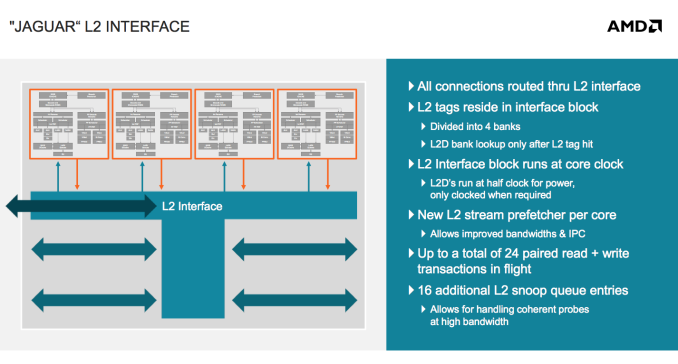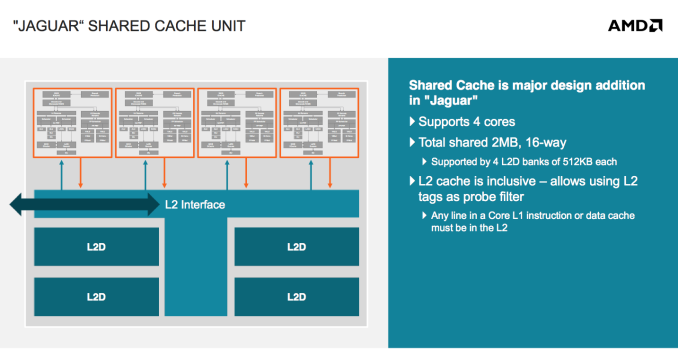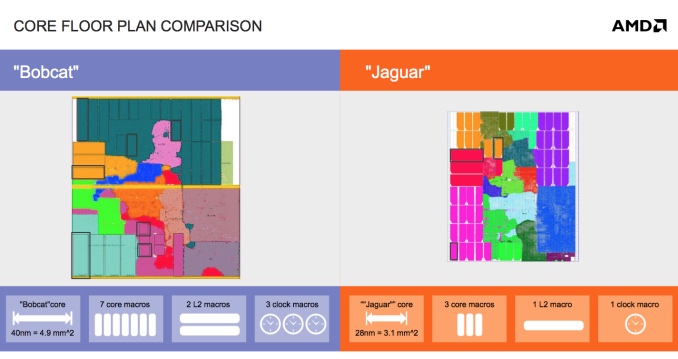AMD’s Jaguar Architecture: The CPU Powering Xbox One, PlayStation 4, Kabini & Temash
by Anand Lal Shimpi on May 23, 2013 12:00 AM ESTCompute Unit
Bobcat was pretty simple from a multi-core standpoint. Each Bobcat core had its own private 512KB L2 cache, and all core-to-core communication happened via a bus interface on each of the cores. The cache hierarchy was exclusive, as has been the case with all of AMD’s previous architectures.
Jaguar changes everything. AMD defines a Jaguar compute unit as up to four cores with a single, large, shared L2 cache. The L2 cache can be up to 2MB in size and is 16-way set associative. The L2 cache is also inclusive, a first in AMD’s history. In the past AMD always implemented exclusive caches as the inclusive duplicating of L1 data in L2 meant a smaller effective L2 cache. The larger shared L2 cache is responsible for up to another 5-7% increase in IPC over Bobcat (totaling ~22%).
AMD’s new cache architecture and lower latency core-to-core communication within a Jaguar compute unit means an even greater performance advantage over Bobcat in multithreaded workloads:
| Multithreaded Performance Comparison | ||||||||||||||||
| # of Cores | Cinebench 11.5 (Single Threaded) | Cinebench 11.5 (Multithreaded) | ||||||||||||||
| AMD A4-5000 (1.5GHz Jaguar x 4) | 4 | 0.39 | 1.5 | |||||||||||||
| AMD E-350 (1.6GHz Bobcat x 2) | 2 | 0.32 | 0.61 | |||||||||||||
| Advantage | 100% | 21.9% | 145.9% | |||||||||||||
The L1 caches remain unchanged at 32KB/32KB (I/D cache) per core.
Physical Layout and Synthesis
Bobcat was AMD’s first easily synthesized CPU core, it was a direct result of the ATI acquisition years before. With Jaguar, AMD made a conscious effort to further reduce the number of unique macros required by the design. The result was a great simplification, which helped AMD port Jaguar between foundries. There’s of course an area tradeoff when moving away from custom macros to more general designs but it was deemed worthwhile. Looking at the results, you really can’t argue. A single Jaguar core measures only 3.1mm^2 at 28nm compared to 4.9mm^2 for a 40nm Bobcat.














78 Comments
View All Comments
Krysto - Friday, May 24, 2013 - link
Still don't see why OEM's would choose AMD's APU's in Android tablets over ARM, though.It's weaker CPU wise, and most likely weaker GPU wise, too. We'll see when they come out if their GPU's can stand up to Adreno 330, PowerVR Series 6 and Mali T628. Plus, it requires quite a bit of power.
In my book no chip that can't be used in a smartphone (and I'm talking about the exact same model, not the "brand") should be called a "mobile chip".
This idea about "tablet chips" is nonsense. Tablet chips is just another way of saying our chip is not efficient enough, so we're just going to compensate for that with a much larger battery, that adds more to weight, charging time, and of course price.
ReverendDC - Monday, May 27, 2013 - link
Even an Atom chip is more powerful per cycle than ARM, and AMD's stuff is more powerful than Atom. I'm not exactly sure what you are using to state that ARM is more powerful, but AnandTech did a great comparison themselves.By the way, the comparisons in some cases are for quad core ARM vs. single core Atom at comparable speeds. Again, really not sure where your "facts" come from.
BernardBlack - Wednesday, May 29, 2013 - link
ARM actually isn't all that...and it's quite the other way around.As I have seen it stated elsewhere, "Simply: x86 IPC eats ARM for lunch while actual performance and power usage will scale together. That is why ARM currently has no real business competing against x86"
BernardBlack - Wednesday, May 29, 2013 - link
It's all about instructions per cycle and that is what AMD and Intel do best.BernardBlack - Wednesday, May 29, 2013 - link
not to mention, the IPC's in these processors follow suit with their server Opteron processors, which means, they achieve even greater IPC's per cycle. This is how you are able to have 1.6ghz CPU's that can compete with many common 3-4ghz desktop processors.eanazag - Friday, May 31, 2013 - link
They could use the exact same hardware design to sell Android and Windows tablets.Wolfpup - Wednesday, June 12, 2013 - link
Huh? AMD's Bobcat parts are more powerful than ARM's stuff. ARM's only just now managing to sort of compete with first gen Atom at best, and that with a CPU that's not actually used in much.And "tablet chips" is NOT nonsense. You have more power budget, and higher expectations for performance in a tablet. If it's "nonsense", why does Apple put bigger chips in their tablets? Why can tablets run Core i CPUs? Why do they typically get bigger chips first even with Android?
Wolfpup - Wednesday, June 12, 2013 - link
To add to that, THIS article explicitly says "Jaguar is presently without competition...nothing from ARM is quick enough."So really, where the heck are you getting the idea ARM has more powerful chips?
kyuu - Thursday, May 23, 2013 - link
I think the main point of this is getting into the mobile market. Temash looks like a great chip for a tablet. The only problem is OEMs not biting because they think they have to put an Intel sticker on the box for it to sell.Personally, I'm waiting on a good tablet with Temash to finally jump into the Win8 tablet club. Whatever OEM makes a good one first will be getting my money.
mikato - Friday, May 24, 2013 - link
I think with tablets, OEMs are even less likely to think they need to put an Intel sticker on it. Joe Schmo knows Intel doesn't mean as much for tablets. The most well known tablets aren't Intel. This is an opening for AMD to be able to get in the game late if they want to.Actually, do they even put stickers on tablets?